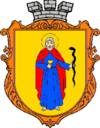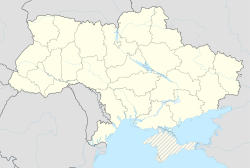Zolkiev, Poland
|
Zhovkva Жовква Żółkiew (in Polish) | |||
|---|---|---|---|
 Zhovkva main market square
| |||
| |||
| Coordinates: 50°4′0″N 23°58′0″E / 50.06667°N 23.96667°ECoordinates: 50°4′0″N 23°58′0″E / 50.06667°N 23.96667°E | |||
| Country |
|
||
| Oblast |
|
||
| Raion | Zhovkva Raion | ||
| Founded | 1597 | ||
| City status | 1603 | ||
| Area | |||
| • Total | 7.64 km2 (2.95 sq mi) | ||
| Population (2013) | |||
| • Total | 13,594 | ||
| • Density | 1,742/km2 (4,510/sq mi) | ||
| Postal code | 80300—80304 | ||
| Area code(s) | +380 3252 | ||
| Sister cities | Kraśnik, Poland | ||
Zhovkva (Ukrainian: Жовква, Ukrainian pronunciation: [ˈʒɔu̯kwɑ]; Polish: Żółkiew; Yiddish: זאָלקוואַ; Russian: Жо́лква, 1951-1992: Нестеров, Nesterov) is a city in Lviv Oblast (region) of western Ukraine. It is the administrative center of Zhovkva Raion (district). Its population is approximately 13,834 (2017 est.).
The site of Zhovkva has been inhabited since the 14th century. Zhovkva was founded in 1594 as a private fortified town by the Polish nobleman Stanisław Żółkiewski, and, like Zamość, was built on an ideal Renaissance city plan. Due to its strategic location at the intersection of important trade routes, the town prospered.
In the 17th century, it became the royal residence for King John III Sobieski of Poland, and a hub of religious life, arts and commerce. From its earliest days, the population was a mix of Poles, Ukrainians and Jews. Landmark buildings include a fortress-like synagogue, churches and monasteries.
From the first partition of Poland in 1772 until 1918, the town (named Żółkiew) was part of the Austrian monarchy (Austria side after the compromise of 1867), head of the district with the same name, one of the 78 Bezirkshauptmannschaften in Austrian Galicia province (Crown land) in 1900.
...
Wikipedia




